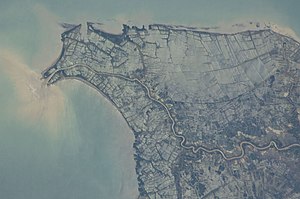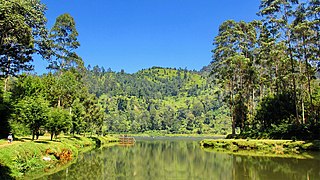| Citarum River | |
|---|---|
 Estuary of the Citarum river | |
| Native name | ᮝᮜᮥᮍᮔ᮪ ᮎᮤᮒᮛᮥᮙ᮪ ( Sundanese) |
| Location | |
| Country | |
| State | West Java |
| Physical characteristics | |
| Source | Situ Cisanti; Mt. Wayang; Mt. Kendang |
| • location | Tarumajaya, Bandung Regency, West Java |
| • elevation | 1,600 m (5,200 ft) |
| Mouth | Jakarta Bay; Java Sea |
• location | Muara Gembong, Bekasi Regency, West Java |
• coordinates | 5°56′29″S 106°59′16″E / 5.941306°S 106.987722°E |
| Length | 270 km (170 mi) [1] |
| Basin size | 6,906 km2 (2,666 sq mi) [2] |
| Discharge | |
| • location | Near mouth |
| • average | 423 m3/s (14,900 cu ft/s) |
| Basin features | |
| River system | Citarum basin (DAS220047) [2] |
| Waterbodies | Jatiluhur dam; Cirata dam; Saguling dam |
| Basin management | BPDAS Citarum-Ciliwung [2] |
The Citarum River ( Sundanese: Walungan Citarum) is the longest and largest river in West Java, Indonesia. [3] It is the third longest river in Java, after Bengawan Solo and Brantas. It plays an important role in the life of the people of West Java. It has been noted for being considered one of the most polluted rivers in the world. [4]

History
In Indonesian history, the Citarum is linked with the 4th-century Tarumanagara kingdom, as the kingdom and the river shared the same etymology, derived from the word "tarum" ( Sundanese for indigo plant). The earlier 4th-century BCE prehistoric Buni clay pottery-making culture flourished near the river's mouth. Stone inscriptions, Chinese sources, and archaeological sites such as Batujaya and Cibuaya suggest that human habitation and civilization flourished in and around the river estuaries and river valleys as early as the 4th century and even earlier.
Geography
The river flows in the northwest area of Java with a predominantly tropical monsoon climate. The annual average temperature in the area is 24 °C. The warmest month is May, when the average temperature is around 26 °C, and the coldest is January, at 22 °C. [5] The average annual rainfall is 2646 mm. The wettest month is January, with an average of 668 mm of rainfall, and the driest month is September, with 14 mm of rainfall. [6]
Hydroelectric and irrigation dams
Three hydroelectric powerplant dams are installed along the Citarum: Saguling, Cirata, and Ir. H. Djuanda ( Jatiluhur), all supplying the electricity for the Bandung and Greater Jakarta areas. The waters from these dams are also used to irrigate vast rice paddies in Karawang and Bekasi areas, making northern West Java lowlands one of the most productive rice farming areas. [7]
The Jatiluhur Dam with a 3 billion cubic meter storage capacity has the largest reservoir in Indonesia. [8]
The river makes up around 80 percent of the surface water available to the people who use it. Pollution has affected agriculture so much that farmers have sold their rice paddies for half their normal price. [9]

Pollution

The river is heavily polluted by human activity; about five million people live in its basin. [10] Textile factories in Bandung and Cimahi were major toxic waste contributors. [11] More than 2,000 industries contaminate 5,020 sq miles of the river with lead, mercury, arsenic, and other toxins. [12] According to the documentary Green Warriors Indonesia by Martin Boudot, some of the other toxins include sulphites, nonylphenol, Phthalates, PCB 180, paranitrophenol, tributylphosphate. The documentary also mentions that the most dangerous pollution comes from the Indonesian textile industry (with many textile factories being part of Asosiasi Pertekstilan Indonesia). It is also mentioned that the textile factory effluents are only tested on a very select number of parameters. It was thus also proposed in the documentary that a revisal of the textile industry guidelines could include more parameters such as sulphites and heavy metals.
On December 5, 2008, the Asian Development Bank approved a $500 million loan for cleaning up the river, calling it the world's dirtiest. [13]
Environmentalists have observed that over 20,000 tons of waste and 340,000 tons of wastewater from those textile factories are disposed of into the river daily. A result of this pollution has been the elimination of a significant part of the river's fish population estimated at 60% since 2008. [14] [15]
In 2011, the Indonesian government began a river revitalization project, aiming to return the whole river to clean drinking water status.
Revitalization
In November 2011, the river revitalization began, with an expected cost of Rp35 trillion ($4 billion) over 15 years. The revitalization is occurring from Mount Wayang through eight regencies and three cities for a distance of 180 kilometers. The target for the first three years is to collect 10.5 million cubic meters of sedimentation. [16] In February 2018, the President of Indonesia Joko Widodo launched a seven-year plan to clean up the whole river to achieve clean drinking-water status, ordering 7,000 regular soldiers to clean up allocated sections of the river regularly. They have the power to block up outlets conveying polluted wastewater from factories into the river and are installing rubbish treatment and water treatment facilities. Problems are - lack of money for continuing action, lack of coordination at the local level, bribes paid by factories to avoid change, and upstream soil erosion from deforestation that enhances the silting of the lower river. But with wider internet publicity, and now the top-down government enforcement, more foreign consultants are coming in to recommend necessary changes upstream, and local awareness and anti-plastics campaigns are beginning to take effect. [17]
See also
- Environmental issues in Indonesia
- Kali Bekasi
- List of drainage basins of Indonesia
- Water supply and sanitation in Indonesia
- Fast fashion [18]
- Buriganga River
References
- ^ Citarum River Basin Management (retrieved 2020-05-20)
- ^ a b c https://hukumonline.com/pusatdata/detail/lt4f2f760d2fff3/keputusan-menteri-kehutanan-nomor-sk511menhutv2011-tahun-2011
- ^ "Citarum Nadiku, Mari Rebut Kembali" (in Indonesian). Greenpeace. Archived from the original on 29 March 2019. Retrieved 4 March 2014.
- ^ Holder, Kristen (25 April 2022). "13 of the Most Polluted Rivers in the World: 2 are in the USA!". a-z-animals.com. Retrieved 2022-12-16.
- ^ "NASA Earth Observations Data Set Index". NASA. 30 January 2016. Archived from the original on 6 March 2015. Retrieved 6 July 2018.
- ^ "NASA Earth Observations: Rainfall (1 month - TRMM)". NASA/Tropical Rainfall Monitoring Mission. 30 January 2016. Archived from the original on 1 April 2017. Retrieved 6 July 2018.
- ^ "Karawang Tantangan Si Lumbung Padi" (in Indonesian). citarum.org. Retrieved 4 March 2014.
- ^ "Genjot Proyek Waduk Jatigede" (in Indonesian). Indopos Intermedia Press. Archived from the original on 30 September 2011. Retrieved 18 April 2014.
- ^ Williams, Alex (30 June 2013). "Citarum: Possibly the world's most polluted river". Inside Investor. Retrieved 30 June 2013.
- ^ Nana Terangna Bukit (1995). "Water quality conservation for the Citarum River in West Java". Water Science and Technology. 31 (9). IWA Publishing (published May 1995): 1–10. doi: 10.1016/0273-1223(95)00400-h. ISSN 0273-1223. Archived from the original on 26 September 2007.
- ^ Nadya Natahadibrata (6 November 2013). "Citarum, Kalimantan world's most polluted". Jakarta Post. Retrieved 9 November 2013.
- ^ Leahy, Stephen (8 November 2013). "Toxic towns and poisoned rivers: a byproduct of industry for the rich". The Guardian. Retrieved 9 November 2013.
- ^ Collins, Nancy-Amelia (5 December 2008). "ADB Gives Indonesia $500 Million to Clean Up World's Dirtiest River". VOA News. Retrieved 24 May 2010.
- ^ "Indonesia's Citarum: The World's Most Polluted River". thediplomat.com. Retrieved 2020-03-05.
- ^ "The Death of the Citarum River: Indonesia's Most Toxic Waterway". Pulitzer Center. 2017-03-13. Retrieved 2020-03-05.
- ^ "Rehabilitasi Total Sungai Citarum Butuh Rp 35 Triliun dalam Waktu 15 Tahun". Pikiran Rakyat (in Indonesian). 10 November 2011. Archived from the original on 11 November 2013.
- ^ Freischlad, Nadine (5 Jan 2019). "In Indonesia, cleaning up the Citarum, 'the world's dirtiest river', is now a military operation". South China Morning Post.
- ^ "Citarum River Is Polluted by Factories That Make Your Clothes". Fabric of the world. 2017-12-18. Archived from the original on 2020-04-27. Retrieved 2020-01-09.
External links
- Indonesia's Most Polluted River. 101 East, Al Jazeera English, 3. Mai 2018 (video, 25 mins)
- Martin Boudot: The world’s most polluted river. DW documentary, 2020 (video, 42 mins)
- "Remote Sensing data application for Citarum River Integrated Management" (PDF). Archived from the original (PDF) on 2007-09-28. (6.29 MiB)
- "The 15 most toxic places to live" via Mother Nature Network
- "Sea of Garbage" — pictures of Citarum River pollution
- "The Dirtiest River In The World" — photos
- Citarum — Bahasa (mainly updated) and English website regarding information on Citarum river recovery effort
- Citarum Knowledge Center — information on research, everything from scholarly publications to tool kits for applied research and policy briefs about Citarum River recovery effort. All materials can be freely downloaded from the site.
- "Rescuing The Citarum River." Sometimes Interesting. 09 Nov 2013